Schema level #
The second level of the catalog explorer is the schema level, which contains a number of panes of information about the currently selected schema.
Header section #
The header for schema level panes shows the name of the currently selected schema and a Promote to data product button. Use the youtube_searched_for reindex icon as described in Catalog indexing.

Schema metadata #
View and edit metadata associated with your schema, such as a description, associated tags, relevant web links, a list of user contacts, and the schema’s owning role.
Click the edit pencil icon to edit schema metadata. Schema metadata can only be edited by the schema’s owner. Metadata is otherwise read-only. If the schema does not have an assigned owner, ownership is inherited from the parent catalog. Tags inherited from the parent catalog are denoted by a subdirectory_arrow_right downward, right-pointing arrow preceding the tag name.
Click Show details to see an expanded view of the schema’s metadata:
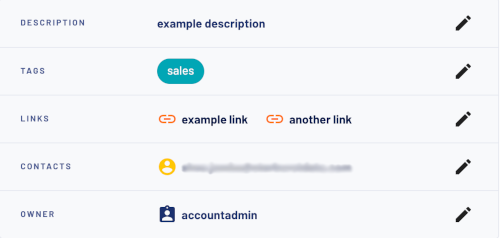
- Description displays the description of the schema, if any.
- Tags lists the tags associated with the schema. Apply tags to the schema to enable attribute-based access control policies.
- Links displays a list of links relevant to the schema. Links consist of a title and a URL.
- Contacts displays users who can provide information and support for the schema. You can add any user with a role that owns the schema directly, or indirectly.
- Owner displays the owner of the schema.
Options menu #
Click the more_vertoptions menu to show the following options for schema level panes:
- Query data opens a new query editor tab with the current catalog and schema pre-selected in the location drop-down menus.
- View notification (Preview). Opens a dialog from which you can set up to be notified if this schema changes or if a quality check fails. See Schema change notifications.
- View history (Preview). Opens a pane that allows you to see and compare snapshots of any schema changes, and to review the change history for this schema. See Compare changes to schemas.
Tables #
The Tables pane displays a list of tables found within the schema. and any tags applied to each. In addition, a Status column show the catalog indexing status for roles with the Manage account work privilege.
Refresh the list of tables, or search through the list by using the Refresh button on the left, or the Search tables field on the right, respectively.
Click the name of a table to open the overview page for that table.

Cluster participation #
The list of Clusters at the bottom of the Tables list shows the clusters that contain the currently selected catalog. The list shows the following information about each cluster:
- Name: shows the name of the containing cluster.
- Status: displays the status.
- Cluster type: Standard, Fault Tolerant, or Accelerated.
- Owner: the role that owns the cluster.
- Actions: Clickable operations to run on this cluster, including:
- Query: Opens a new query editor tab with the current catalog and schema pre-selected in the location drop-down menus.
- more_vert
Options menu. Click to show:
- Partner connect: Directs you to partner connect where you can get the connection information required to connect to the cluster from various client tools.
- Add privileges: Opens an Add privileges dialog that allows you to add roles that have access to this cluster.
Views #
The Views pane displays a list of views and materialized views found within the schema.
You can refresh the list of views, or search through the list by using the Refresh button on the left, or the Search views field on the right, respectively.
Click the name of a view for details on any schema views.
Metrics #
The Metrics pane displays a visual analysis of important metrics about the current catalog, schema, table, or view:
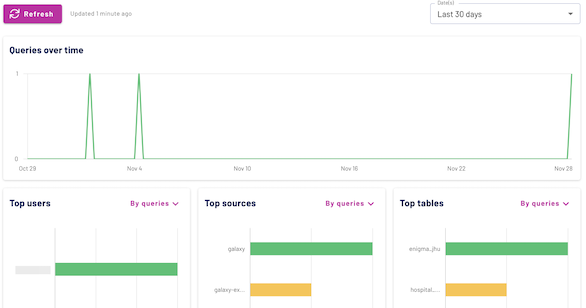
Use the Dates menu above the chart to view data for different time intervals.
Charts display the following metrics:
- The Queries over time chart shows the absolute number of run, queued, and failed queries.
- The Top users chart shows the most active users by processed queries, by used CPU time, by data read, or by data written.
- The Top sources chart shows the most active client applications, such as the query editor, the Trino CLI, and others by processed queries, by used CPU time, by data read, or by data written.
- The Top tables chart shows the most active tables and views by processed queries, by data read, or by data written.
Quality #
View the results of data quality checks or create new data quality checks in the Quality tab at the table, schema, or catalog levels of the catalog explorer. See Data quality for further information.
Definition #
The Definition pane displays the results of a SHOW CREATE SCHEMA
statement for the current schema.
- Click the code Edit icon to open the statement in the query editor.
- Click the content_copy Copy icon to copy the statement to the clipboard.
-
Click the fullscreen Expand icon to view the full query text.
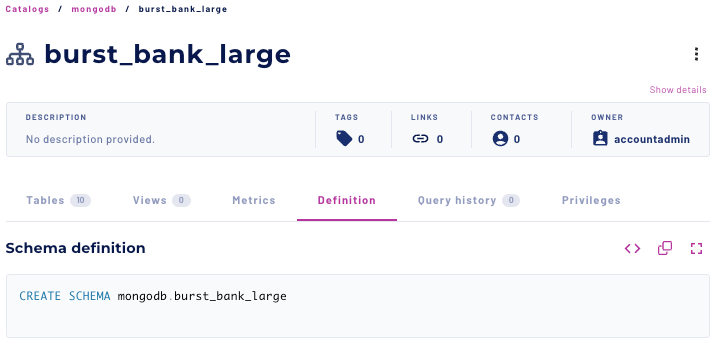
Query history #
The Query history page shows a list of queries that accessed this schema. Look for queries that occurred within a pre-defined date range using the Dates menu on the right.
Query history is limited to your role’s history unless your current role is
accountadmin or your role has the View all query
history privilege.

Click Refresh to reload queries in the list.
The following columns are displayed:
- Status uses check for successfully completed queries, and close for failed queries.
- Query ID shows the unique identifier for each query; click the ID to open the Query details pane for the query.
- Cluster is the name of the cluster used to process the query.
- Query text displays the full or partial SQL text of the query.
- Email identifies the user who submitted the query.
- Role specifies the name of the role used by the user when submitting the query.
- Submitted date uses the browser timezone and shows the start date and time of the query processing.
- Elapsed time is the total duration for processing the query.
Audit log #
The Audit log pane displays an audit trail of administrative actions related to this catalog and its schemas, tables, views, materialized views, and columns. Your current role must have the View audit log privilege in order to see audit log entries from all users.
The following columns are shown:
- Operation: The configuration change that was performed. Possible values include update, delete, suspend, and others depending on the object.
- Object: The type of object, such as catalog or schema, for which the configuration was changed.
- Object name: The name of the specific object.
- What changed: A description of the changed attributes including values.
- User: The user who performed the change.
- Time of change: The date and time the change was performed.
Privileges #
User accounts with permission to view privileges have access to the Access control pane. The Access control pane allows you to view privileges based on the currently active role.
The following columns are displayed:
- Role specifies the name of the role.
- Privileges shows the privileges for the role and ownership rights.
Use the Add privileges button to add or remove access to a privilege:
-
Select a role from the menu.
-
By default, new privileges allow access rights, but you can click the deny switch to create a deny privilege.
-
Select the privileges to grant to the current role, and click the Add privileges button to save the privilege grants.

To revoke an existing privilege:
- Click the X on a privilege tag.
- In the resulting dialog, click Yes, revoke privilege.
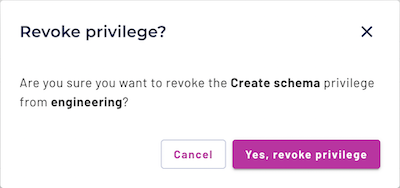
Options menu details #
The options menu for schema-level panes in the catalog explorer includes the following features.
Schema change notifications #
Set or review in-app notifications about changes to your schemas, tables, or views.
CREATE statements. It only sends
notifications about changes made using ALTER and DROP statements.Click the Set/View notification option in the more_vert options menu to open the Set in-app notification settings dialog.
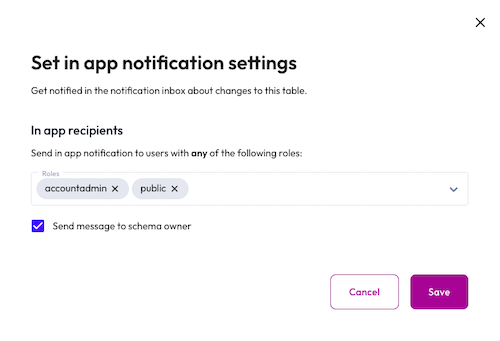
Use the Roles drop-down menu to choose one or more roles to receive notifications.
Select the Send message to schema owner checkbox to send notifications to the asset owner in addition to the specified roles.
Compare changes to schemas #
Starburst Galaxy captures changes made to each schema. You can review when each schema change occurred.
The Schema snapshots tab shows a list of records for the past 31 days. You can choose how many results appear in the list by changing the Rows per page.
Changes made within the past 24 hours appear in the Daily diff column. Select the link to see the most recent changes. To compare changes made during a specific date range, select up to two records, then click Compare selected records.

Use the expand_morearrow to expand and collapse each record. See what has changed, what has been added, and what has been removed.
Use the Start and End drop-down menus to compare records for different dates.

Use the Change history tab to filter change history results by table name and dates.
Select the name of a table from the Table drop-down menu and a date from the Dates drop-down menu. Available dates are Today, Yesterday, Last 7 days, and Last 30 Days. Results appear in a list, which displays the following information:
- Operation: Which action was performed.
- Object: Whether a table or column was changed.
- Object name: The name of the schema in which the change was made.
- What changed: Describes the change.
- User: The account in which the change was made.
- Time of change: When the change occurred. Click the column name to reverse the sort order.
The search bar correlates with the What changed column. Enter a table name or column name to narrow the result set.

Is the information on this page helpful?
Yes
No
